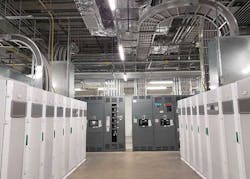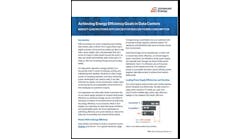Last January we identified eight themes that we believed would shape the data center business in 2019. How did we do? Let’s take a look, ranking whether each prediction was a Hit, Miss or Too Early.
What’s ahead for 2020? Watch for our annual “Eight Trends” forecast on Monday, Jan. 6. You can also receive updates so you don’t miss our analysis.
1. Hyperscale Deals Get Bigger
PREDICTION: Industry watchers keep waiting for the demand for hyperscale data centers to ease. I mean, the campuses and leasing deals can’t possibly keep getting bigger, can they? They can, and they will in 2019. In 2018 CloudHQ reportedly signed a 72-megawatt lease in Ashburn, the largest deal in data center history. That record likely won’t last long. Multiple industry sources say that there will be a 100-megawatt deal in 2019, and maybe more than one.
MISS. It turns out that hyperscale demand could ease. The hyperscale sector remains enormously important, and by many standards had a solid year. But let’s face it, 2019 wasn’t a continuation of the extraordinary upward trajectory seen in 2017 and 2018. Leasing was lumpy and the rumored 100-megawatt deals never materialized.
The lesson: Don’t take hyperscale expansion for granted, as capacity planning remains a huge challenge for the cloud computing platforms. There’s widespread expectation that hyperscale data center growth will accelerate again in 2020. But will that growth show up as wholesale leasing or company-built campuses? Stay tuned.
2. Niches Abound: A Market of Markets
PREDICTION: Hyperscale is just one niche within an increasingly diverse set of opportunities for data center developers and service providers. Market segmentation is emerging within the traditional categories of wholesale (dedicated data halls, suites and build-to-suits) and retail colocation (multi-tenant environments with tenants renting cabinets and cages). … On the colocation front, there are targeted opportunities in major markets, second-tier markets, and interconnection strategies – including new connectivity ecosystems at landing sites for subsea network cables. But the biggest and broadest set of opportunities may be in the nascent field of edge computing.
HIT. It was a big year for several market segments, especially the interconnection business, which saw robust growth and acquisitions by tower operators American Tower and SBA Communications as they explore the potential impact of edge computing. SDN-driven “cloud connectivity” players like Megaport and Packet Fabric continued to gain traction. Meanwhile, Macquarie’s acquisition of Netrality suggests there may be M&A action ahead in the market for carrier hotels. And there was robust activity in the subsea sector, as cable landings continue to gain prominence as strategic assets shaping data center site selection.
As for edge computing, 2019 was a year of laying the groundwork for future growth, but it’s increasingly clear that this will be a meaningful market for digital infrastructure (more on this in a moment …).
3. Staffing Challenges Test the Industry
PREDICTION: Finding quality staff is becoming a challenge, and will grow in urgency in coming years with the graying of the existing workforce. One of the most important challenges is in data center construction, where teams are being tasked with building bigger and faster, across multiple major markets.
HIT: Staffing challenges continued throughout 2019. Overtime has become a fact of life on construction projects in major markets, especially Northern Virginia. Meanwhile, industry players see a growing opportunity in providing third-party services for facilities management and construction, as seen in T5 Data Centers’ pivot to focus on these markets.
Concern about the future workforce prompted the 7×24 Exchange to launch International Data Center Day to raise awareness among students, and it was also a year when diversity was front and center in the discussion about building a better workforce. Expect more of the same in 2020.
4. New Money: Deeper Pockets, Longer Horizons
PREDICTION: There’s a whole new class of investors in the data center sector, including infrastructure funds and sovereign wealth funds with deep pockets and extended time horizons. Their activity has been scaling up over several years, but 2019 is the year where their impact will be felt, in the form of data center campuses in major markets. Infrastructure funds, which traditionally have invested in projects like airports and toll roads, tend to have longer timelines for return on investment than private equity funds, which have been the prime movers in data center investing.
HIT. It’s hard to overstate the impact of infrastructure funds, which are driving the industrialization of the data center sector. The deep pockets of global investors are bringing greater efficiencies to data center deployment, and creating new platforms to compete with incumbent players. The data center industry has historically had a high barrier to entry, due to the capital-intensive nature of the business and the limited availability of qualified executives.
The entrance of infrastructure funds and sovereign wealth investors has changed the game, and the maturing industry now has an ample supply of experienced executive teams. This creates challenges for existing players, who face stiffer competition. But it also suggests there will be ample capital to meet the growing global appetite for digital infrastructure.
5. Construction Gets Leaner, Meaner
PREDICTION: Profit margins and return on invested capital will be an important topic this year, particularly for publicly-held data center companies that are scrutinized every quarter by Wall Street analysts. With more new players entering the data center sector, pricing could become even more competitive. For some developers, this will mean finding ways to generate the same return with slightly lower leasing rates. This shifts the focus to the cost of capital and the cost per megawatt to deploy new capacity. Investment grade credit ratings may seem like a boring topic. But investment grade ratings will get sexier in 2019, as they translate into the ability to borrow money at lower interest rates.
HIT. Credit ratings proved sexy indeed for Equinix and CyrusOne, which each gained investment grade status and access to cheaper capital in 2019. As we predicted, companies including Vantage Data Centers and STACK Infrastructure used securitized debt offerings to access capital at lower interest rates. Global financial firms like the infrastructure and sovereign wealth funds (as well as telecom giant NTT) also can fund growth at low interest rates.
The bottom line: Capital efficiency was a huge trend in 2019, and will continue to influence the industry for years to come.
6. Enterprise: All Aboard the Hybrid Train
PREDICTION: The enterprise shift to colo and cloud was our top trend in 2018. It will be a big business driver once again in 2019. It’s not new or sexy, but it is a major driver of data center growth, along with new technology adoption. There are subtle shifts along the curve in the way this shift is described and spun, as seen in the embrace of “hybrid” in 2018. The bottom line is that we’ll continue to see a rational reallocation of enterprise IT resources across cloud platforms, colocation facilities and on-premises data centers.
HIT: This was our safest prediction for 2019, and will likely be a safe bet again in 2020. The ongoing IT migration from on-premises data centers to colo and cloud providers is a multi-year transition, and continued to gain momentum in 2019. As we noted in our 2019 forecast, a trend doesn’t have to be new and bright and shiny to have a major business impact. That’s hybrid cloud.
7. Liquid Cooling: Finally Ready For Its Closeup?
PREDICTION: Yeah, I know. The imminent arrival of large-scale liquid cooling is one of the longest-running predictions, and always seems to hover near the horizon. But the rise of high-density workloads for AI is nudging this trend ahead in a meaningful way. In 2018 there were two news events that suggested we’re finally on the brink of more meaningful adoption of liquid cooling.
TOO EARLY: I was tempted to count this as a hit, particularly given the growing number of reports that density is trending higher, driven by the growing adoption of high-density AI hardware. This was the most significant movement yet towards this long-foreseen trend. But the actual adoption of liquid cooling remains limited, and “the needle is moving” doesn’t quite equate to a Hit on this one.
8. Edge Transition: A ‘Boring’ Present Sets Up the Sexy Future
PREDICTION: In many ways, 2018 was the year of Edge Enthusiasm, chock full of ambitious visions for a world transformed by new technologies. And yes, more than a little hype and “edgewashing.” We see 2019 as a transition year, as the market awaits the full arrival of 5G wireless which many analysts see as a 2020 event. Many of the hot new latency-focused will take time to generate demand. But there will be plenty of action on the edge in 2019. Most of the here-and-now applications for edge infrastructure involve the growing tsunami of data that must traverse the network.
HIT: It was indeed a transition year for edge computing. As we expected, managing network economics and M2M data tonnage has come into focus as an edge business model, alongside the sexier latency-driven future applications you’ve heard so much about (autonomous cars!). The element of this prediction that remains in question is whether 5G wireless will be a 2020 event or perhaps 2021 or 2022.
How did we do? Six Hits, one Miss and one “Too Early” score. We’ll take it. Remember to watch for our Eight Trends for 2020 next week.






